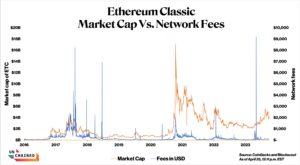Why Many ‘Zombie Blockchains’ Still Indulge in Market Caps within the Billions of Greenbacks

When a public company falters and is delisted to the penny stock enviornment, shopping and selling grinds to a live and its valuation plummets as stockholders carve their losses and switch on.
Equities alternate upon a save of residing of advance-universal fundamentals that rob the upward thrust and tumble of their company’s fortunes into legend. A cadre of blockchains, however, picture that crypto loyalists were playing by heaps of rules. And what they’re worth would possibly presumably well have extra in current with striking a brand on a Chanel purse or an Hermès scarf.
Most ceaselessly known as “zombie blockchains,” these networks have minimal developer activity, few lively pockets addresses, little transaction search recordsdata from, or a combination of all three, but are ready to raise extensive valuations.
The causes appear like a combination of their intangible qualities, longevity in surviving a pair of crypto cycles, and the presence of trusty adherents avidly promoting their liked networks.
Suki Yang, CEO of Solana shopping and selling platform xBot, told Unchained that “cryptocurrencies, arguably, are doubtlessly the most successful and doubtlessly the most productive asset class that basically capitalizes on intangible values.”
These intangible parts consist of neighborhood and culture, moreover as a current and presumably unconventional perception about what a token is worth — plus open air perceptions of engagement around a community. They add as much as play a predominant role within the valuations held by crypto zombies.
Yang, who’s additionally a recordsdata scientist at crypto-focused project firm Electric Capital, in comparison the crypto industry to the trend industry in this admire.
Within the trend world, brands fetch their worth partly from the tangible: the quality of a fetch, the clarity of a gemstone, or the burden of a material. However their brand additionally stems from intangible traits: the logo’s social situation, historical past, and storytelling skill.
Of us don’t exhaust hundreds of bucks on Chanel or Hermès utterly essentially based utterly mostly on the exclusivity or quality of leather, essentially based utterly mostly on Yang.
“It’s because of of the intangible brand of what does [the product] bid about me after I raise that fetch,” Yang acknowledged.
Like high-model enthusiasts, token holders don’t appropriate have confidence their cryptocurrencies from a quantitative, utility viewpoint, but as a replace maintain in strategies intangible values as piece of general funding concerns, Yang acknowledged.
What Makes a Zombie Blockchain
Forbes just no longer too prolonged within the past labeled 20 blockchains as zombies essentially based utterly mostly on the real fact that that they had valuations of extra than a thousand million greenbacks “even though they’re unproven and have little utility rather than for speculative crypto shopping and selling.”
These 20 blockchains had a collective market capitalization of extra than $100 billion, representing about 4.7% of the sizzling market cap of all cryptocurrencies of about $2.4 trillion.
Forbes specifically named the following networks as crypto zombies: XRP (XRP), Cardano (ADA), Bitcoin Cash (BCH), Litecoin (LTC), Files superhighway Computer (ICP), Ethereum Traditional (ETC), Stellar (XLM), Stacks (STX), Kaspa (KAS), Fantom (FTM), Monero (XMR), Arweave (AR), Algorand (ALGO), Circulation (FLOW), MultiversX (EGLD), Bitcoin SV (BSV), Mina (MINA), Tezos (XTZ), Theta (THETA), and EOS (EOS).
Representatives for 15 of those blockchains didn’t return Unchained’s requests for enlighten.
While Forbes’ checklist of zombie blockchains mostly “made sense,” Nate Crowningshield, public relations manager for Kaspa, told Unchained that Kaspa’s inclusion didn’t. Per Crowningshield, zombies indicate death, and Kaspa is peaceable a young community that most productive rolled out in November 2022.
Kaspa, which commands a $3 billion market cap, has roughly 30 contributing developers, Crowningshield acknowledged. By incompatibility, Optimism, which had 574 developers within the past week essentially based utterly mostly on blockchain analytics firm Artemis, has a market cap of $2.6 billion.
Then again, Crowningshield acknowledged Kaspa’s brand is derived from the community’s technology of peek-to-peek digital cash, moreover as future potentialities of perfect contract functionality and a consensus overhaul that will change contemporary coding language Gallop alongside with the extra broadly long-established Rust.
Ethereum Traditional (ETC), which forked from Ethereum in 2015, is one other example of a zombie chain cited by Forbes. It’s the fifth biggest proof-of-work chain by market cap with a figure of $3.9 billion, listed on many exchanges, and just no longer too prolonged within the past recorded 24-hour shopping and selling volumes north of $200 million. And but, Ethereum Traditional had appropriate three developers and 24 GitHub commits within the past week, recordsdata from Artemis highlights. And blockchain explorer Blockscout reveals that between April 17-23, Ethereum Traditional had an total of appropriate 14.992 ETC in transaction charges, or roughly $390.
However Bob Summerwill, govt director of the ETC Cooperative, which helps and promotes the community, denied that Ethereum Traditional is a zombie. “The worth proposition of these trend of ‘zombie chains’ is broader than appropriate transactions per 2nd or whatever other metric you care to indicate… ETC is itsy-bitsy, but it no doubt shouldn’t be any longer a ‘zombie,’” Summerwill told Unchained by X.
He added that it’s no longer at all times like many other project capital-backed chains, which have “enormous funding, gargantuan TVL, media campaigns, and ecosystem grants programs.”
Litecoin Basis’s director of communications, Jay Milla, additionally rejected the foundation that Litecoin is a zombie in an electronic mail to Unchained, pointing to Glassnode recordsdata out how Litecoin’s community activity exceeded that of Bitcoin’s a pair of times within the past year.
The ‘Lindy Enact’
Paradoxically, the zombie chains which were limping alongside the longest, will seemingly be the in all probability to continue soldiering on. Rob into legend that Litecoin, launched in 2011 and now the oldest within the class of zombie chains, has a market cap of $6.2 billion but an total brand locked of appropriate $5.16 million.
The longevity phenomenon will seemingly be explained by what’s is known as the “Lindy raise out,” which defines the existence expectancies of things akin to technologies or strategies. In fact, programs with prolonged histories customarily tend to have longer futures ahead than newer creations. That’s in piece because of novel iterations of present products face steeper opponents to gain on.
Surviving appropriate one or two crypto cycles, as has Bitcoin Cash, which debuted in 2017 as a Bitcoin fork, can create the general distinction — resulting in “a ton of Lindy raise out, even when of us are no longer necessarily the utilization of that necessary of your product or your chain,” xBot’s Yang acknowledged, alongside side that longevity “creates a ton of brand.”
Despite having a market cap of end to $10 billion, Bitcoin Cash had appropriate 17 developers within the past week, per Artemis, and $49,225 in full community charges for all of 2023.
The Position of Whales, Founders, and Gamblers
One other cause within the support of zombie blockchains’ persevering with high valuations is that wide token holders continue to pump them.
Jim Hwang, chief operating officer of crypto funding firm Firinne Capital, told Unchained in a textual say material message that “social media, shilling by founders and true adherents, etc. are keeping costs above their intrinsic values.”
This unmooring from intrinsic brand would possibly presumably well tie support to the open of the blockchains, with convention increasing allocations for “gigantic parts of the total circulating supply to their founding teams,” essentially based utterly mostly on Sam Callahan, a senior analyst at Swan Bitcoin.
“This means the bid circulating supply is much smaller than marketed, allowing these founding teams to with out concerns manipulate the worth of their illiquid tokens upwards, enriching themselves and artificially inflating their blockchain’s market cap,” Callahan acknowledged.
Apart from, when predominant token holders open to promote, the thinly traded markets would possibly presumably well tank the token brand. As a result, it’s in doubtlessly the most attention-grabbing hobby of whales and founders no longer to dump impulsively, which helps maintain valuations high. “They are within the commercial of developing obvious that costs don’t tumble too necessary,” Yang acknowledged.
Pointless to convey, some token holders don’t care about fundamentals and blockchain technology, marking “a illness among the speculators in this industry,” wrote Andrew Smith, founding father of blockchain scaling startup Versatus, over Telegram. Some alternate because of “they care about rising their fiat baggage, so here’s successfully a mechanism to gamble with out going to a casino,” Smith added.
Then again, since crypto zombies have nothing, Yang postulated that “injurious recordsdata” doesn’t genuinely apply to zombies. Yang pointed to Litecoin let’s assume. With zero fundamentals and no working product, Litecoin can’t genuinely be hacked. Plus, LTC is “certainly no longer a security, because of it doesn’t attain the leisure,” essentially based utterly mostly on Yang.
“When you occur to suspect about it, it’s no longer going to zero at this point, appropriate?” Yang acknowledged. “[When] you’ve bought no fundamentals, of us can’t fault you for shit.”
Source credit : unchainedcrypto.com

